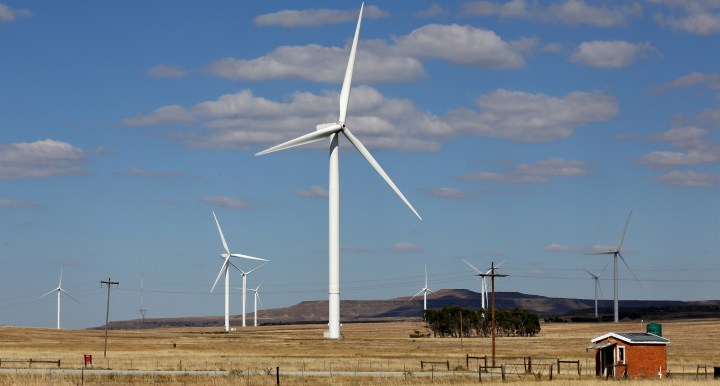POWER CRISIS OP-ED
Grid capacity a significant obstacle to renewables transition and fixing load shedding

Countries across the world are having to redesign their grids to cater for the fact that power generation from renewables changes the geography of electricity supply. Grid capacity and the design of the grid are significant impediments to addressing load shedding and transitioning to renewables.
In the ongoing energy debate in South Africa, a previously under-explored element – electricity transmission – is getting increasing attention. Transmission refers to the transportation of bulk electricity from where it is produced to distribution centres, via high voltage cables, and then onwards, through low voltage cables, to consumers.
The transmission and distribution systems make up the “grid”.
Both are key to determining where, when and at what price the country can get new generation on to the grid. New generation is critical if the country is going to increase the supply of electricity and address power cuts, as well as make the transition from coal-based electricity to renewables.
Grid capacity – and the design of the grid – is a significant impediment to addressing power outages and transitioning to renewables.
This is not a uniquely South African problem. Countries across the world are having to redesign their grids to cater for the fact that power generation from renewables changes the geography of electricity supply.
According to Mark Hutchinson, director for Asia at the Global Wind Energy Council, “I don’t know of any country where the grid is not currently some level of obstacle to the energy transition.”
In South Africa, the upgrading of the transmission grid has become particularly urgent amid long power outages. But it will require heavy investment. Choices the country makes will affect whether the transition is in fact a just and equitable one.
Wealthy households can “leave” the grid and install their own renewable energy systems. But those who cannot afford to do so will carry the burden of increasing electricity tariffs and the cost of grid upgrades and maintenance.
An urgent review of the electricity tariff structure and free basic electricity is therefore required to avoid exacerbating inequality and energy poverty.
Gridlock
Transmission is by its nature complex and expensive. On top of this, renewable energy technologies add a new set of challenges.
In South Africa, the current transmission network is built primarily around coal-fired power stations in Mpumalanga, a coal mining area in the northeast of the country. Electricity is sent out to the rest of the country from these plants.
But the richest renewable energy potential is further south and to the west, in the windiest and sunniest parts of the country – the Northern Cape and parts of the Eastern Cape and Western Cape.
The grid was designed to transport electricity from Mpumalanga to the rest of the country, with high-voltage cables that reach cities and towns and low-voltage cables which support distribution to homes. This means that the grid is not designed to transport electricity in the opposite direction due to the prevalence of low-voltage cables in the western regions which are quickly gridlocked by excess electrical capacity.
This historical grid design has rapidly reached capacity for new generation in the western parts of the country.
This has become evident in the 2023 bid window 6 for the Renewable Energy Independent Power Producers Procurement Programme (REIPPPP).
The REIPPPP is an auction system where private producers put forward bids to produce and sell renewable energy to Eskom and the top bids are selected in line with planned capacity.
For the first time, bids that would otherwise have been successful could not be accepted as there was simply no capacity for them to connect to the grid. Thus, grid capacity and the design of the grid are significant impediments to addressing load shedding and transitioning to renewables.
Delays
The limited ability of grids to take on new electricity generation has resulted in long waiting times for new renewable energy developments in a host of countries. For example, in the UK, waiting times are up to 15 years. This means that there is 200GW worth of electricity waiting to come online in the UK – more than three times South Africa’s total installed capacity.
In the US, waiting times average five years, with about 2,000GW waiting to come online. This delay is enough to cause many developers to pull out, with only one-fifth making it through the process.
Even in cases where a grid connection does exist, developers may be responsible for any necessary grid upgrades required to make the grid connection viable – a process which can increase the costs and make a project commercially unsustainable.
Globally, it is estimated that the grid needs to more than double by 2050, requiring an investment of almost $550-billion a year by 2030, accounting for as much as 30% of energy transition costs.
This is an area that has historically been neglected in energy transition debates and remains under-resourced, but governments are increasingly aware of this problem and are taking several steps to address it.
Changing the queuing rules
Several countries are changing their “queuing rules”. Many grid operators have, until now, operated on a “first come, first served” basis, which has meant that preference for connection to the grid was based on the projects which signed their connection contracts first.
However, this meant that projects which saw delays or were far from construction, could “hog” grid space, while those that were ready had to wait.
Therefore, the US, UK and South Africa are all changing their rules to “first ready, first served” to ensure that those most ready to connect are pushed to the front of the queue.
Numerous other proposals have been made for how to address this issue.
A report on transmission for energy security by the Blended Finance Taskforce and the Centre for Sustainability Transitions at Stellenbosch University makes a few suggestions:
- Focusing new generation capacity at sites where there is available grid capacity (even if the renewable energy potential is not necessarily optimal); and
- Maximising the amount of renewable electricity entering the grid at any one time by compensating for intermittency through mechanisms such as overbuilding and voluntary curtailment (building more generation capacity than is technically required and then reducing electricity generation when necessary to maintain a balanced grid).
Grid-enhancing technologies are also being used in several parts of the world, which include devices and software that optimise the amount of electricity that can be passed through transmission lines at any point in time.
However, these approaches have their limitations. They are likely to alleviate the problem temporarily. They are also expensive, and ultimately massive investments will need to be made now to increase total grid capacity in the medium and long term.
This raises the question of how these investments will be financed, and who will ultimately bear the costs of this reconfiguration of the system. Decisions on how this financing will occur are likely to have significant long-term implications for consumers.
The cost – and who will pay
In South Africa, the responsibility for expanding the grid will fall to Eskom’s new National Transmission Company which received its licence to operate in July 2023.
Eskom estimates that about 14,200km of extra-high-voltage lines and 170 transformers will be needed by 2032 to accommodate new, mostly renewable, generation capacity. This is likely to cost about R210-billion within the next 10 years. While some international finance has been provided, this is not nearly enough.
Several power stations in Eskom’s fleet reach the end of their useful lives in the next several years and require replacement – this is a good opportunity to replace coal with renewable energy in a just manner and contribute to South Africa reducing its carbon emissions. This cannot happen without addressing the constraints imposed by the grid.
Despite the reduced costs in the production of electricity from renewable sources, the costs of a broader shift to an electricity system based on renewables are high, which, if passed on to consumers (currently the plan with cost-reflective tariffs), will increase energy poverty in South Africa.
While some have suggested the use of blended finance mechanisms, this approach could, unless well-regulated by competent regulators, see undue gains for private financiers and increased risk for the state, with critical national infrastructure at stake.
These considerations must be included in transmission planning and the just energy transition as it will determine the winners and losers from the process. DM
Katrina Lehmann-Grube is an associate researcher on the Climate Change and Inequality Project at the Southern Centre for Inequality Studies.
Julia Taylor is a researcher on Climate Change and Inequality at the Southern Centre for Inequality Studies. Previously, she was researcher and climate policy lead at the Institute for Economic Justice where she worked with labour unions on a vision for a just transition.
Imraan Valodia is Pro Vice-Chancellor for Climate, Sustainability and Inequality, and Director of the Southern Centre for Inequality Studies (SCIS), at the University of the Witwatersrand.
Rod Crompton is an adjunct professor at the African Energy Leadership Centre at Wits Business School. He was previously a full-time board member at the National Energy Regulator (Nersa) and a deputy director-general at the Department of Minerals and Energy.
Jason Huang is a planning and development manager at Wits University’s Campus Planning and Development Department. He is responsible for the planning of the university’s bulk services infrastructure.
Ian Jandrell is Deputy Vice-Chancellor: Systems and Operations at the University of the Witwatersrand. He is a member of the Executive Committee of the SA Academy of Engineering.




















 Become an Insider
Become an Insider
Failing to plan is planning to fail, the most basic engineering management principle. We are reaping the results of political incompetence coupled with dishonesty on an unprecedented scale whilst our so called leaders remain in problem denial mode
Hi – thank you for a great article – any thoughts on mirco-grid, LANs and WANs (to borrow an IT term)?
While I understand the focus on equality in this article, given the authors’ roles, I feel that it’s worth pointing out that a large number of South Africans currently get their electricity for free – via electricity theft. To place the cost burden of the urgently needed grid upgrades on the small and declining number of law-abiding taxpayers is simply giving added impetus to those with skills thinking about emigration.
The problems highlighted here show a global failure of imagination. If your centralised distribution strategy doesnt work, decentralise it. There is no need for electritcity generated in the northern, western or eastern cape to be patched to the rest of the country – consume the renewables there and then. Its not rocket science guys.
Yes, distributed micro-generation is good too, but you have perhaps missed the point of this great article.
No, I really didn’t. Perhaps you should elaborate?
This article is full of generalisations. Please we need specifics, not what happens overseas, but what the grid looks like here in SA and where it needs to be enhanced. Perhaps the reality of the situation will placate the unions about coal mine closing versus many sub-stations being built etc.